Ethan Bartlett
Salvation, in three movements
This piece was inspired by the reading of Ruskin’s work in Modern Painters, specifically the essay ‘Of Truth of Space’ where he speaks about how we see things at distances. I was further influenced by the stained-glass illustrations by Frank Randal, commissioned by Ruskin and available to view on the Sheffield Museums catalogue. When translating Randal’s, I was influenced by the art of the Modernist poet-artists David Jones, specifically his work In Parenthesis. Taking guidance from his featureless faces and dense verse, the piece aims to detail the movement of humans from the death of the muse to our own death, to finally the death of the future.
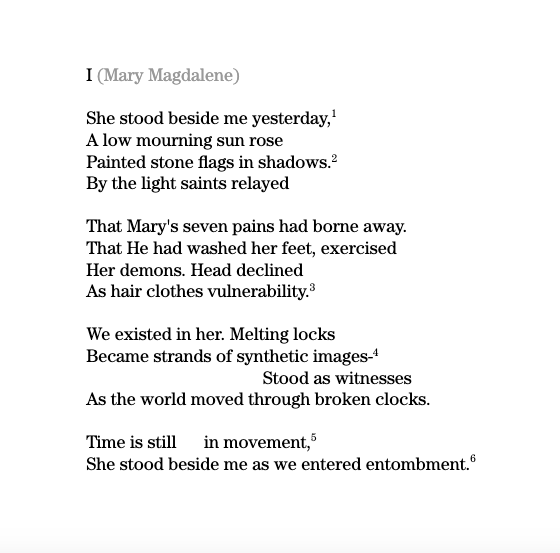
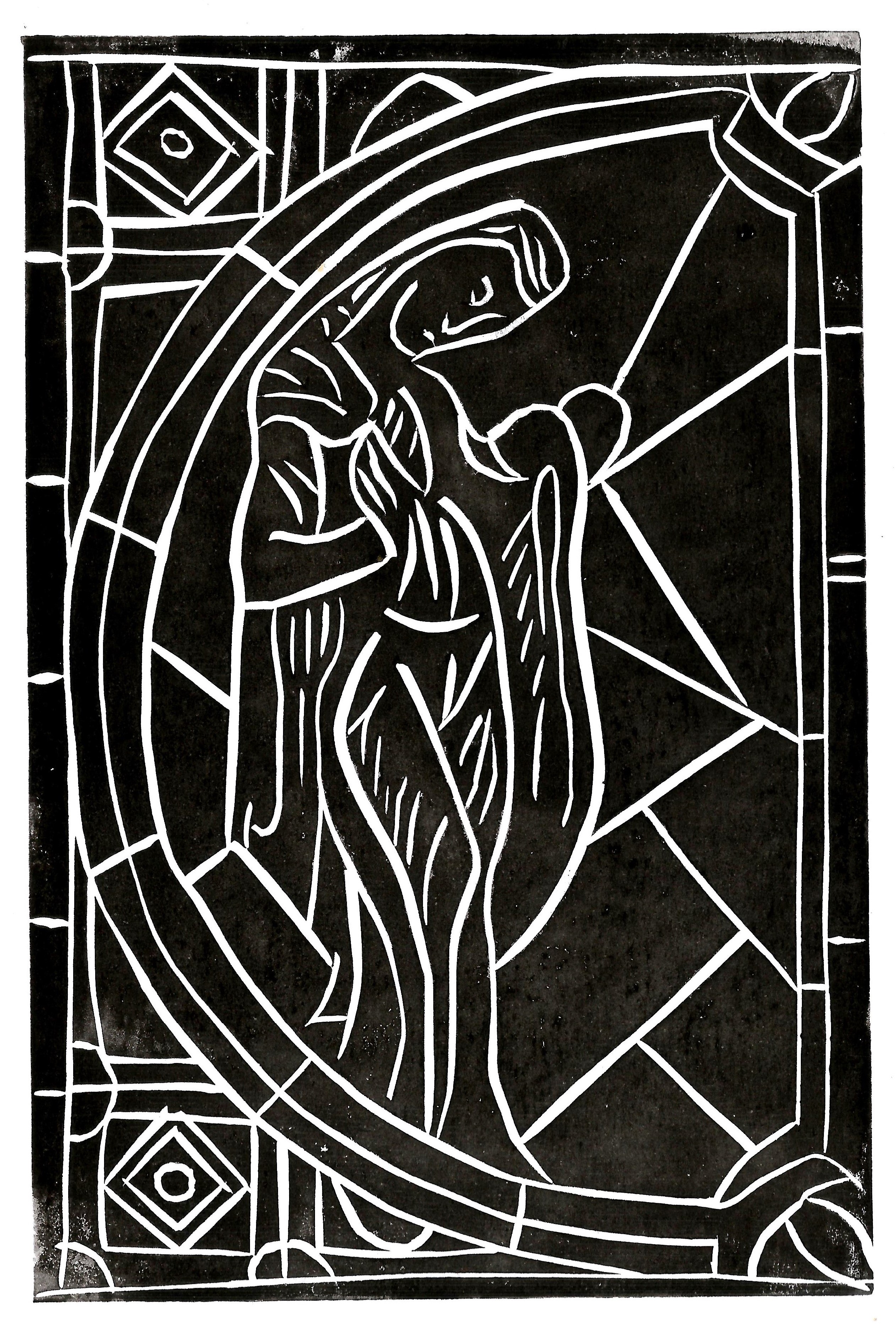
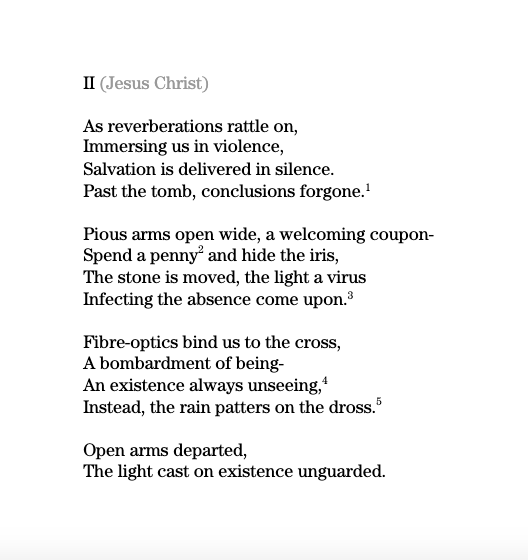
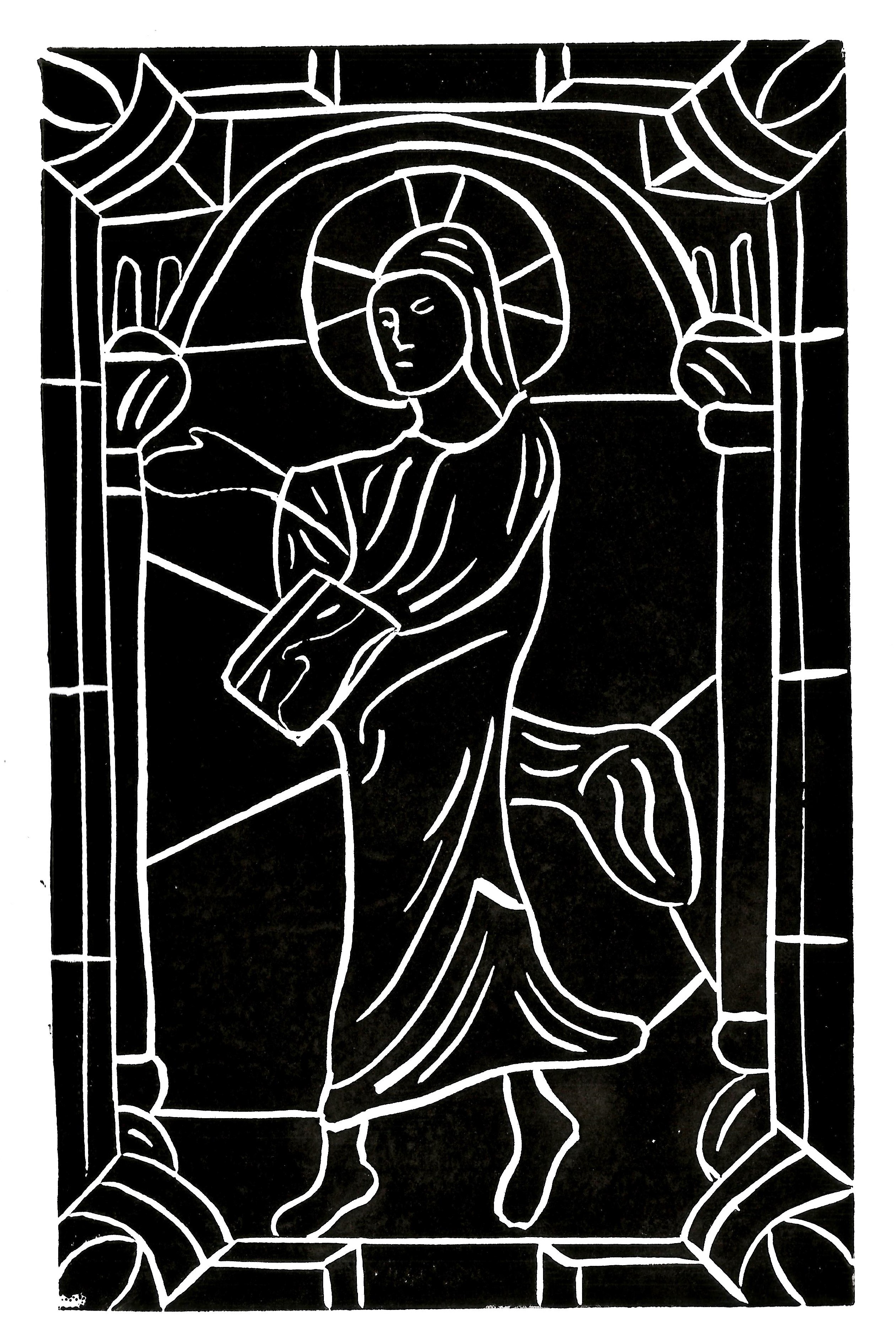
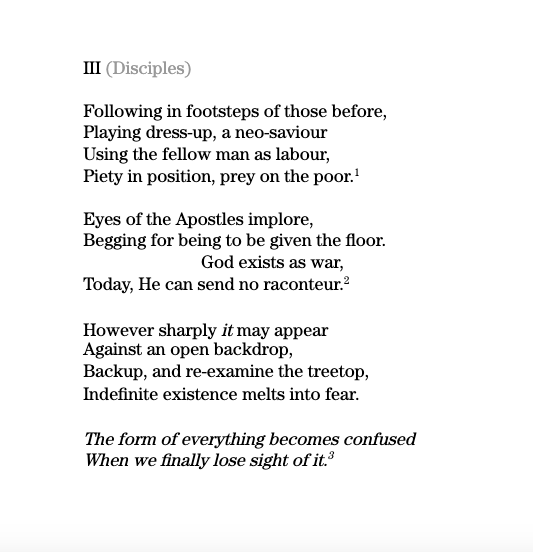

Notes
‘Salvation in Three Movements’ is a poem concerned with the passage of time under capitalism, transforming the image ‘Study of Stained Glass, 'St Mary Magdalene and Jesus', Bourges Cathedral, France’ by Frank Randal (1852-1917) (below) into Linocut prints. The intention behind the art style was to imitate the style of David Jones (1895-1974), specifically the image prefacing his Modernist epic In Parenthesis called ‘Frontispiece’. His style is abstract, and features faces and bodies that are disconnected from a reality, presenting the trauma of war. In the modern trauma of hyper-capitalism, the development of which Ruskin aired his grievances, and the increasing digitisation of existence a sense of Being (that is the essence of existence) is lost, the figures depicted in the prints are expressionless to stress this sense of loss and disconnect from Being.
Taking from the modernists, the verse is dense and features a lot of references to Ruskin and beyond. At points directly quoting him. The verse was largely influenced by Ruskin and Jones and is concerned with a movement from past to present to future in detailing our relationship as a Spinozian extension of the world, meaning that the earth is the whole and as humans we are extensions of the earth, and how the muse; embodied in Mary Magdalene has died and we are slowly following, Jesus Christ being the present, and the Disciples being the future.
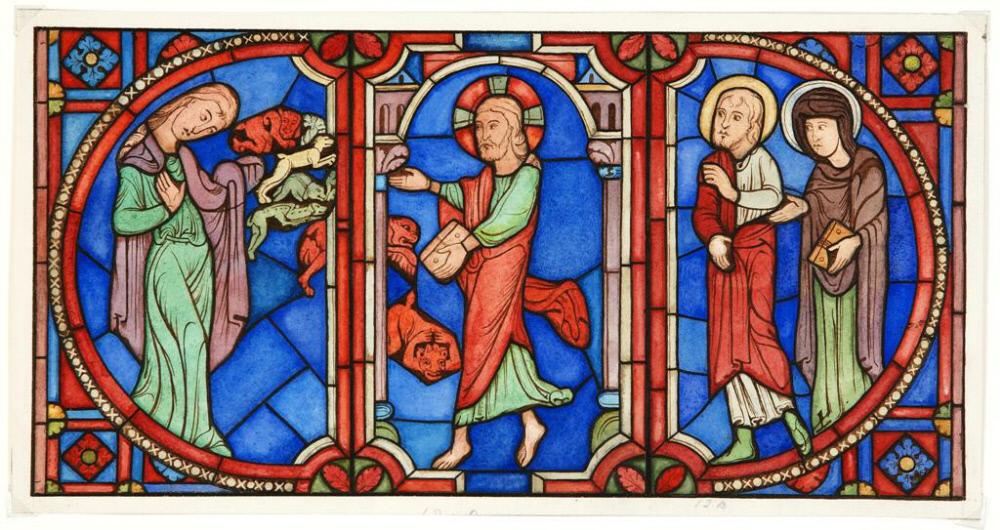
Study of Stained Glass, 'St Mary Magdalene and Jesus' , Bourges Cathedral, France, 1883. Frank Randal , British, 1852 - 1917. Watercolour on paper. CGSG00754
Part One – Mary Magdelene.
Part One concerns itself with the muse in the past tense, referring to the loss of the muse, which in the case of the wider poem is the Earth. Transforming the image of Mary Magdalene as subservient and previously a fallen woman, instead as a profoundly tragic figure.
- She stood beside me yesterday – Quote from Ruskin’s poem “The Last Smile” a poem about the loss of his muse Rose La Touche at 27.
- Painted stone flags in shadows – An image of walking among memories in the form of shadows.
- That Mary’s seven … clothes vulnerability – An inversion of the traditional Christian image of Mary Magdalene as a subservient woman, rather she is doted on by Jesus. But this inverted image exists in memory as explored in the following stanza.
- Melting locks … Synthetic Images – As humans we need to mediate the images we see of the world, and through that we clothe our vulnerabilities through synthetic sense of Being. Note the Garden of Eden analogy where they used leaves to cover themselves, our first sin is being conscious of existence and thus trying to deal with that. ‘Synthetic Images’ specifically quotes Jacques Derrida’s Spectres of Marx and his ideas on hauntology.
- Stood as witnesses … in movement – All we can do is stand and watch as we feel still but the world moves. Time goes on regardless of us tracking it, so while nostalgia and memory is a pastiche we keep trying to live in, the world moves.
She stood beside me as we entered entombment – La Roche died and thus she has become a memory, a memory of Being but also in a wider sense, same with Mary Magdalene, no longer a person but a symbol. They are both being used as symbols for the world as humans enter our self-embalming.
Part Two – Jesus Christ.
Part Two is in the present tense and deals with the sense of our current Being passing and any salvation, reason or even absence from our constant death is impossible. Any attempt at respite in suffering is lost. The image of Jesus as the Saviour is lost, his death is a memory that haunts modern existence.
- As reverberations … conclusions foregone – An image of the modern word as constantly in noise, that a distraction from it is in silence, salvation is the removal from existence under capitalism, and to achieve that (in the specific setting of a city) is to achieve a silence that can never exist. Past Jesus’ death a conclusion, or an unshackling of the chains, is now unattainable.
- Pious arms … Spend a penny – Crude reference to using the Bathroom, but also a comment on the commercialising of religion, an alignment with neoliberal capitalism, you must spend money to witness the greatness of God, rather than being able to take it for oneself.
- The Stone … come upon – Image of both Plato’s cave analogy and the revealing of Jesus’ empty tomb. Ignorance is bliss; when the stone was moved, and Jesus' tomb was empty evokes the purity of the light cast on absence. The absence of reason and a sense of being in the modern word is exemplified by clarity becoming a virus not an elixir.
- Fibre-optics … unseeing – We are bound to the immediacy of our current being by being constantly plugged into the source of the synthetic images.
- Instead, the rain patters on the dross – “Son of man are the worthless slag that remains after silver is smelted. They are the dross that is left over—a useless mixture of copper, tin, iron, and lead” (Ezekiel 22:18)
Part Three – Disciples.
Part Three is in the future tense and should be read as the marking of a future that is the totality of Neoliberal economics and Neo-Conservative moral and social rhetoric. Neo-Conservatives pine for a time that has never existed, instead expanding the claws of death that capitalism rakes in profits while creating a morality based on reactionary Christian values. This part of the poem seeks to criticise the future we are heading towards while also attempting to come to terms with the inevitability.
- Following in footsteps … the poor – Within the hyper-capitalist system we exist in today religion has been co-opted for the purpose of presenting a morality system that benefits capitalism and the ruling classes by using reactionary conservative rhetoric to prey on the proletariat for the purposes of financial gain. Religion has become a mode of capital in the same form as a business, degrading individual spirituality for a totality of values that benefit capital and its holders.
- Eyes of the Apostles … no raconteur – Those true in the following of what is deemed as neo-Spinozism through the lends of western Christianity are begging for there to be a reconnection with the earth for the value of our own continued existence, while for the holders of capital the intent is to generate more at the expense of humanity. Thus, God exists only in war, the class war, for the purposes of the bourgeoisie to maintain control via the aforementioned reactionary neo-Conservatism. The Prophets are dead, and it is profit that has killed them.
- However sharply … lose sight of it – From Ruskin’s ‘Of Truth of Space’ in his 1843 work Modern Painters, I. In discussing how humans absorb images, and how that influenced the artwork of J.M.W. Turner, Ruskin uses a thought experiment where he asks the reader to look at something and slowly increase the distance, at which point its details fade and it becomes a single entity. Echoing a sense of loss in clarity of existence under capitalism. The commodification of being has meant that, as directly quoted from Ruskin in the closing lines, we have lost sight of a being as an extension of the earth, instead we are individualised for the sake of profit. Thus, we have lost sight of a genuine existence for a synthetic neo-Conservative one that benefits capital.



These personal responses to the Ruskin Collection, the ideas expressed within them and any original artwork reproduced here, are the copyright of the individuals involved.
